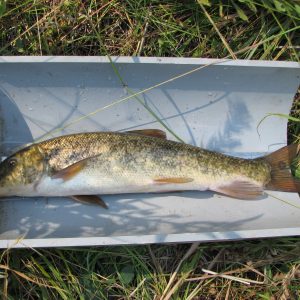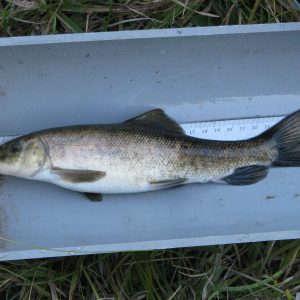Thus far September has been a lovely month to be in the desert. Some intense monsoons have brought a lot of moisture to the area. The result has been magnificent: lush ocotillo, a variety of flowers in bloom, and beautiful skies. It has been a very pleasant time to be out in the field.
Green sunfish removal has been the focus over the last month. A contract crew from Phoenix has made two week long visits to Bonita creek. We are slowly catching less and less non-native fish! The native populations of Gila Chub and Sonora Sucker seem to be doing really well. A couple minor flood events have occurred in Bonita creek, one which blew out several of our nets. Several days of frantic searching for the lost nets ensued, but fortunately we were able to locate all of the missing units. The contract crews are done for the year, but our BLM crew will continue our non-native removal efforts throughout the winter.
We have also visited a couple new monitoring sites over the last month. One day we took a long bumpy road out to Spring Canyon. It is mostly a dry canyon, but a short portion has annual water and is home to a population of Longfin dace, a native endangered fish species. We were able to monitor adults and juveniles in the population and also spotted some Lowland leopard frogs. Success!
When in the office I have been working on summary data for non-native removal and from monitoring data from different sites. We have also been preparing for the grand opening of the greenhouse at the Discovery Park Campus. I have prepared information cards for all of the plants we will be growing out for restoration projects. At the grand opening there will also be a native pollinator plant give-away. I made care-cards for all of these plants so people have information on how to take care of their new plants. This has been a nice way to refresh myself on all the different plants we will be growing.
I have also had the opportunity to volunteer with game and fish doing desert tortoise monitoring. I traveled to Phoenix and spent the day hiking around Sugarloaf mountain in search of hidden desert tortoises. Not only did the crew track the 15 juveniles in their juvenile movement study, but 3 additional tortoises were spotted, as well as a Western Diamondback rattlesnake and a Tiger rattlesnake. I also made it out to another Sky Island Alliance volunteer weekend working at the Cobra Ranch, a Nature Conservancy property. We planted native grass seedlings at their native grass hay farm. It was a wonderful cloudy day to be playing in the dirt.
Another great month 🙂
-Rosalee

























